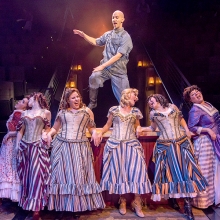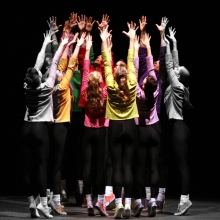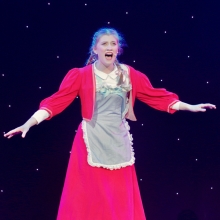Show History
History
Inspiration
In 1953, Robert Griffith (who worked with Hal Prince in the George Abbott production office) read a New York Times review of Richard Bissell's novel, 7 1/2 Cents. Griffith called Prince and asked him to read the book quickly. Prince liked the book and he and Griffith quickly obtained the stage rights; this would be their first show as a producing team. They showed the book to George Abbott in the hopes of contracting him to direct the as-yet-unwritten and unnamed show. Abbott, at first uninterested, agreed to direct if a talented playwright could be found to adapt the novel.
They were turned down by the many major book writers, composers and lyricists that they approached, apparently all put off by the prospect of writing a humorous show about a labor strike at the same time that the McCarthy Senate Committee was destroying the careers of many artists. Abbott thought of the title, The Pajama Game, and suggested to Prince and Griffith that he and Bissell co-write the book of the show. Bissell agreed and moved his family from Dubuque, Iowa.
After turning it down himself, composer, Frank Loesser, recommended Richard Adler and Jerry Ross, newcomers who had written most of the songs in the 1953 revue, John Murray Anderson's Almanac, and the 1953 pop song hit, "Rags to Riches." In two days, they wrote four songs on "spec," (meaning for no money). They were hired, and all four songs were later used in the show. The rest of the songs were written in five weeks.
Productions
The Pajama Game is a musical based on the Richard Bissell novel, 7 1/2 Cents. It features a score by Richard Adler and Jerry Ross with a book by Bissel and co-director, George Abbott. In the original production, Jerome Robbins was credited as the other co-director, with choreography by Bob Fosse.
Following successful pre-Broadway runs in New Haven and Boston, The Pajama Game opened at the St. James Theatre in New York on May 13, 1954, to great reviews. It starred John Raitt as Sid Sorokin, Janis Paige as Babe Williams, Eddie Foy, Jr., as Hines and Carol Haney as Gladys. The show closed in 1956 after 1,063 performances, becoming only the eighth musical in Broadway history to run over 1,000 performances. In conjunction with its initial Broadway run, the show toured for two years with Larry Douglass and Fran Warren playing Sid and Babe.
The original London West End production opened at the London Coliseum on October 13, 1955, where it ran for 588 performances.
Then, in 1957, Warner Bros. released a film version starring most of the original Broadway cast except for Janis Paige, who was replaced by Doris Day.
There have been three New York revivals of the show. The first was in 1957 at the New York City Center. The Pajama Game was next revived in 1973 (directed by George Abbott), starring Hal Linden, Barbara McNair and Cab Calloway. Roundabout Theatre Company produced a 2006 Broadway revival (directed and choreographed by Kathleen Marshall), starring Harry Connick, Jr., Kelli O'Hara and Michael McKean. The revival included three additional songs by Richard Adler. The original book by George Abbott and Richard Bissell was revised by Peter Ackerman.
In 2014, a 21-week limited engagement revival began in London's West End under the direction of Richard Eyre.
Along with these high-profile productions, The Pajama Game has become a classic and favorite among regional, educational and community theatres throughout the country.
Cultural Influence
- When first-choice choreographer, Jerome Robbins, was unable to do the show, Joan McCracken, a Broadway performer, recommended her husband, Bob Fosse, as choreographer. Fosse had appeared as a dancer in Broadway shows and films and wanted to begin choreographing for Broadway. Thus began the choreographic career of the legendary Bob Fosse.
- A then-unknown Shirley MacLaine, who understudied Carol Haney in the role of Gladys, was discovered and signed to a deal at Paramount Pictures by Hollywood producer, Hal Wallis, when he happened to be in the audience on a night that she went on for Haney.
- In addition to the film, The Pajama Game has spawned five soundtrack recordings, including those from the movie cast, the original Broadway cast, the revival Broadway cast, the London studio cast and the original London cast.
Trivia
- In addition to awards won, The Pajama Game was nominated for another six Drama Desk Awards, seven Outer Critics Circle Awards, including Outstanding Revival of a Musical at both of those ceremonies, and seven Tony Awards.
- The Pajama Game had 164 investors for its initial Broadway run, including members of the chorus and backstage employees.
- Prince and Griffith were so short of money that they functioned as their own stage managers, both to save money and to draw salaries. Because of this, neither Prince nor Griffith actually saw the show from the audience until months into the Broadway run.
- Two of the songs, "There Once Was a Man" and "A New Town Is a Blue Town," were actually written by Frank Loesser, although they were not credited.
- The song, "The World Around Us," was part of the 1954 Broadway previews and opening, but was dropped during the first week of the Broadway run, replaced by Babe's reprise of "Hey There." This would leave Sid with no songs in the second act, aside from the "There Once was a Man" reprise. The number was restored for the 2006 Broadway revival, allowing star Harry Connick, Jr., to have a second-act song.
- For the 1973 revival, in place of the second-act song, "Hey There" reprise, there was a new number, "Watch Your Heart." Retitled "If You Win, You Lose," the song has been heard in recent productions of the show and was heard in the 2006 Broadway production.
-
Originally approached by legendary author/director, George Abbott, to pen the score for The Pajama Game, Frank Loesser turned it down, but recommended his two protégés, Richard Adler and Jerry Ross, for the job.




